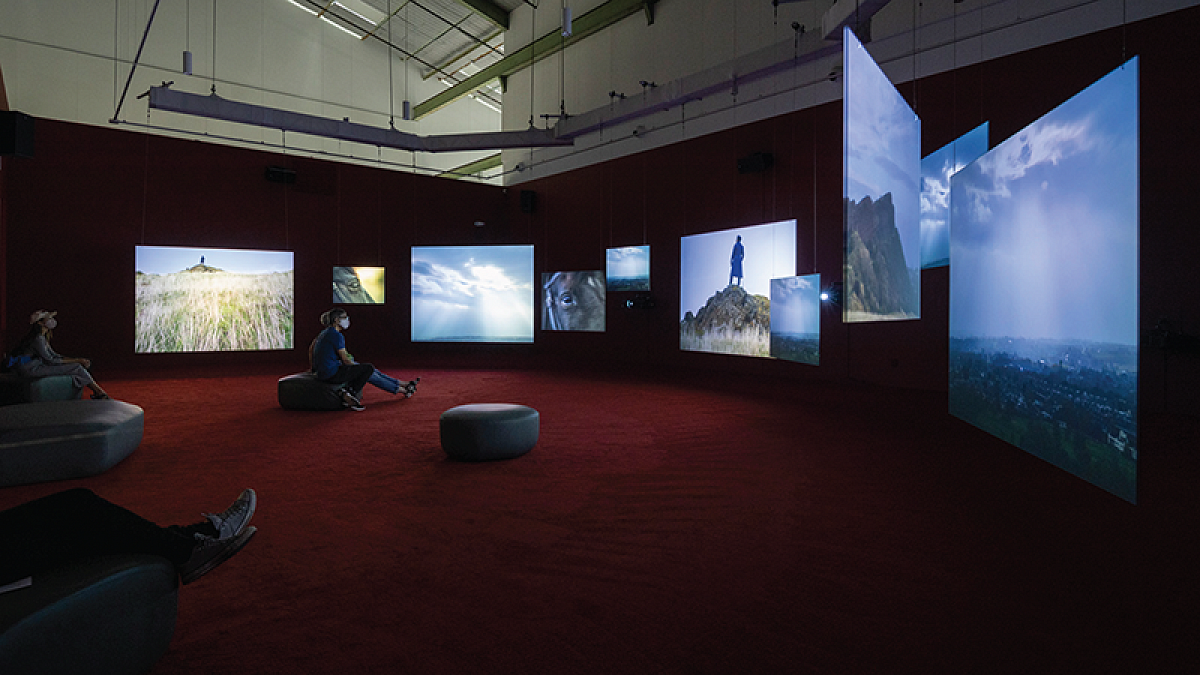The University of Oregon’s Jordan Schnitzer Museum of Art presents the Oregon debut of “Lessons of the Hour — Frederick Douglass,” an immersive, multiscreen film exhibition by British filmmaker and installation artist Sir Isaac Julien.
On view through Dec. 10, “Lessons of the Hour” explores the life of Frederick Douglass — the visionary African American writer, abolitionist, statesman and freed slave — through selected excerpts of his most compelling speeches and moments from his private life.
The 10-screen film installation collapses time and space, alternating between contemplative, poetic sequences reflecting Douglass’s long life and travels, and moments of passionate political oratory.
"The JSMA is honored to present Isaac Julien’s work, and we are particularly thrilled to feature his powerful and nuanced film installation about Frederick Douglass,” said John Weber, the museum’s executive director. “We have been planning this exhibition since 2019, and there has never been a media installation of this complexity, ambition and historical significance shown here before.”
Frederick Douglass, 1818-95, is a pivotal figure in the history of abolitionism and social reform in the United States. An escaped and then freed slave, Douglass developed his oratorical skills as a preacher before embarking on anti-slavery campaigns across the northern United States and the United Kingdom, where he expansively documented the sensations of freedom from enslavement and other forms of racial discrimination he felt there as opposed to the United States.
He was active in the women’s suffrage movement and published three autobiographies that continue to wield cultural influence. Throughout his lifetime, Douglass, the most-photographed American of the 19th century, was a prominent proponent of that medium as a means by which Black people could control their likenesses beyond caricature.
Julien’s video narrative is informed by Douglass’s powerful speeches. It includes excerpts from “Lessons of the Hour,” “What to the Slave Is the 4th of July?” and the prescient “Lecture on Pictures,” which examines the emergence of photography and its potential to influence human relations.
Ray Fearon, a British Shakespearean actor, portrays Douglass within the film. Around Fearon’s portrayal, Julien weaves passages of Douglass’s writings and filmed reenactments of the abolitionist’s travels in the United States, Scotland and Ireland. Those scenes are interspersed with contemporary protest footage.
“Lessons of the Hour” is presented across 10 video screens of varying sizes, creating a 29-minute, ever-changing montage of image and sound. It includes sequences shot in Washington, D.C. at The Frederick Douglass National Historic Site, where Douglass lived late in life and where his house in Cedar Hill has been kept conserved as it was during the abolitionist's time.
Other sequences were filmed in Scotland, where Douglass was an active member of the "Send Back the Money" movement and delivered anti-slavery speeches, and in London's Royal Academy of Arts, to an audience that includes both 19th century characters and contemporary, real-life scholars and royal academicians.
The installation is accompanied by a significant catalogue available in the musuem store, including scholarly essays by Henry Louis Gates, Deborah Willis and others.
Born in the London’s East End to parents who migrated from the Caribbean island of Saint Lucia, Julien is an internationally known filmmaker and artist whose work has been shown in major exhibitions and film festivals since the 1990s and collected by museums worldwide.
Before focusing on video installations such as “Lessons of the Hour,” he became known for early films such as 1989’s “Looking for Langston,” about the Harlem Renaissance figure Langston Hughes, and 1991’s “Young Soul Rebels,” which won the Semaine de la Critique prize for best film at the Cannes Film Festival. His films, photography, single-channel and multiscreen video installations have been featured in “Isaac Julien, What Freedom Means to Me,” a retrospective exhibition at Tate Britain in London, surveying his work across four decades.
In 2022, Queen Elizabeth knighted Julien “for services to diversity and inclusion in art.” He divides his time between his London studio and the University of California, Santa Cruz, where he is a distinguished professor of the arts.
—Top photo: The Jordan Schnitzer Museum of Art has a multiscreen film exhibit on the life of Frederick Douglass


